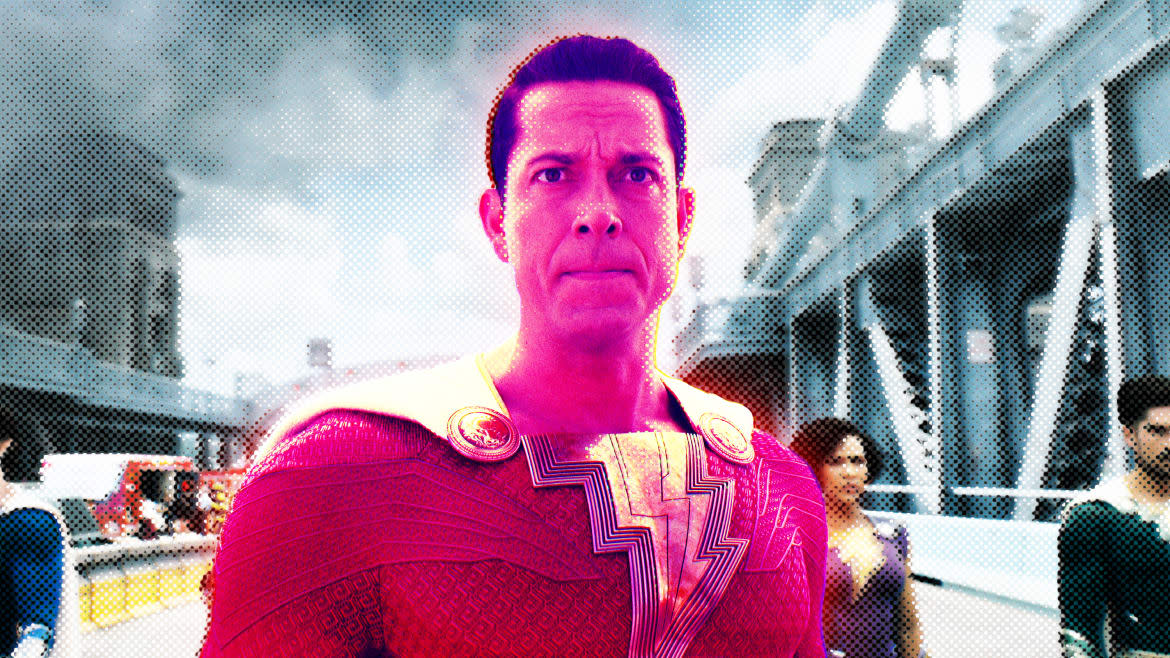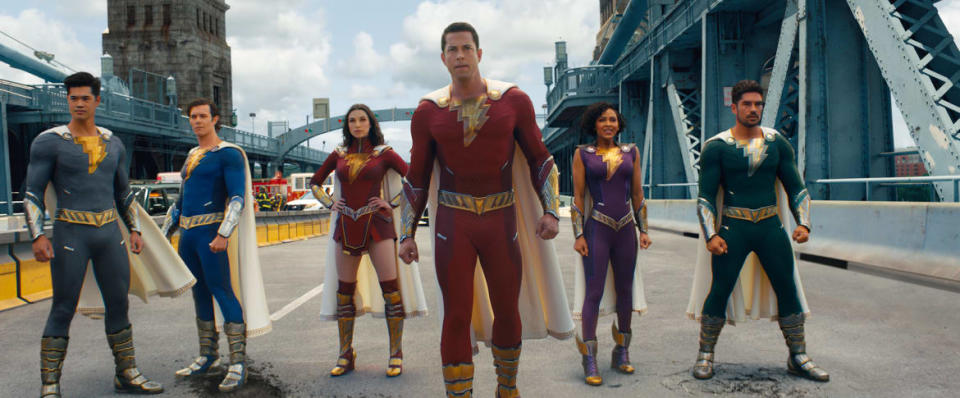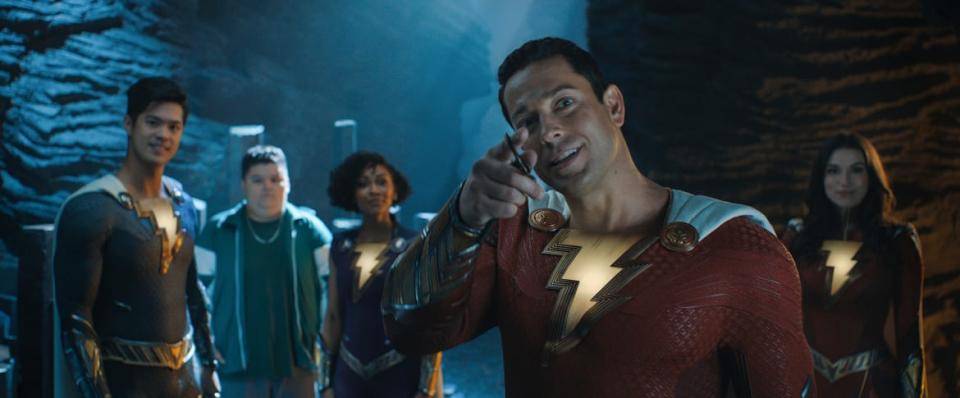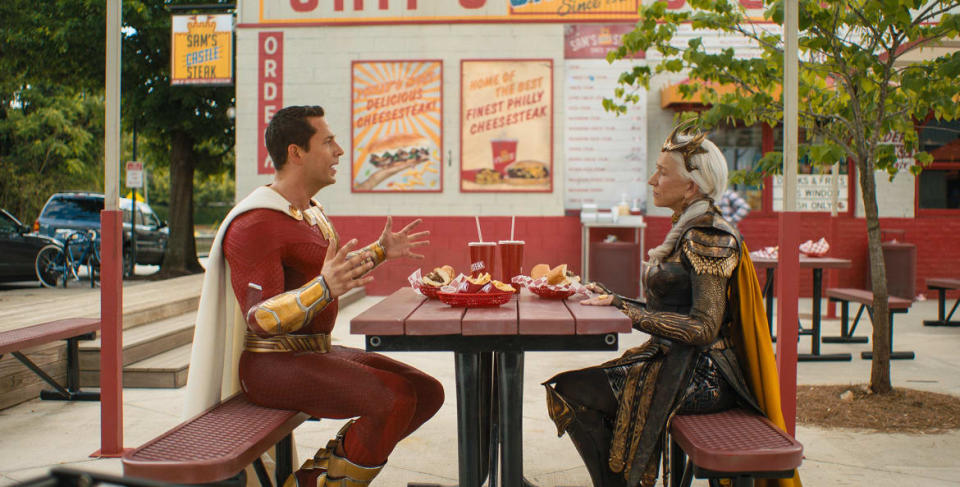‘Shazam! Fury of the Gods’ Is So Bad You’ll Be Begging for James Gunn’s DC Reboot

- Oops!Something went wrong.Please try again later.
- Oops!Something went wrong.Please try again later.
- Oops!Something went wrong.Please try again later.
- Oops!Something went wrong.Please try again later.
Following a string of creative and commercial disappointments, and in light of an overriding plan and structure that might generously be called disjointed, DC Studios recently hired James Gunn and Peter Safran to right its movie universe’s wayward course.
On the basis of Shazam! Fury of the Gods, that reboot can’t come soon enough. A sequel whose goofiness extends not only to its lame humor but its convoluted and senseless plot, David F. Sandberg’s film is something like the light-side equal to last fall’s Black Adam—fitting, given that the antihero of that Dwayne “The Rock” Johnson vehicle is a classic Shazam villain. Messy and mirthless, it resounds as the death knell for this interconnected cinematic enterprise’s current iteration.
Picking up shortly after the events of its 2019 predecessor, Shazam! Fury of the Gods (in theaters Mar. 17) finds Shazam (Zachary Levi)— the god-like alter ego of teenage orphan Billy Batson (Asher Angel)— exclaiming, “I feel like a fraud” and bemoaning his consuming “imposter syndrome.”
From the outset, it’s difficult to disagree with those sentiments, and not only because Shazam remains eerily similar to Superman. Embodied by Levi (in a muscle suit) as an excitable 17-year-old in a goliath’s body, he continues to be the comic-book equivalent of Tom Hanks’ character from Big, except minus the charm. Levi leans heavily into his aw-shucks immature routine, but whether he’s exuding unwarranted cockiness thanks to his extensive magical abilities or exclaiming exasperatedly after taking a super-beating, his Shazam is a grating doofus who rarely elicits a laugh.

At the conclusion of his prior adventure, Shazam shared his powers with his fellow Philadelphia foster home brothers and sisters—Eugene (Ross Butler/Ian Chen), Mary (Grace Fulton), Pedro (D.J. Cotrona/Jovan Armand), Darla (Faithe Herman/Meagan Good) and wisecracking best friend Freddy Freeman (Jack Dylan Grazer/Adam Brody)—which helped him save the world as well as solidify their status as a family.
In Shazam! Fury of the Gods, however, he’s worried that his compatriots aren’t taking his “all or none” mantra to heart, more interested in going it alone than working as a team. Billy’s fear of abandonment compels him to cling too tightly, thereby exacerbating his problems, which also include mockery from the public, who refer to his less-than-perfect squad as “Philly’s Fiascos.” That’s just the beginning of his troubles, since he’s soon forced to square off against heavenly adversaries with a particular ax to grind against humanity.
(Warning: Some spoilers ahead.)
The New ‘Dungeons & Dragons’ Movie Actually Rules
Those would be Hespera (Helen Mirren) and Kalypso (Lucy Liu), the Daughters of Atlas, who arrive in the City of Brotherly Love and promptly steal the magical staff that once contained their father’s powers. Apparently, when Shazam previously broke this rod in two, it freed Hespera and Kalypso from imprisonment, and now they want to restore their own powers as well as find a seed that will let them grow a new Tree of Life in their own realm. Or at least, that’s the general gist of Shazam! Fury of the Gods’s plot, which is full of so much gobbledygook that it’s almost impossible to parse—a situation that allows the film to skip over numerous questionable plot points, the first being why Anthea (Rachel Zegler), the third Daughter, initially pretends to be a high-schooler who’s sweet on Freddy.
Anthea’s true nature comes as no surprise because Shazam! Fury of the Gods telegraphs its every move, all while having its good and bad guys engage in banter that’s painfully desperate to amuse and, as such, inspires only eyerolls.
To combat this new threat, Shazam and his buddies take to their lair, the Rock of Eternity, which houses two secret rooms—one featuring myriad floating doors that function as portals; the other a vast library with flying books whose pages act as wings—that are unimaginatively modeled, respectively, after Monsters, Inc. and Harry Potter. Later, Kalypso rides a roaring dragon and Shazam jokingly refers to her as “Khaleesi,” thereby completing a dreary pop culture-referencing hat trick—although since Levi’s protagonist also cites The Fast and the Furious, the film doesn’t just stop at three.

Despite past events to the contrary, Djimon Hounsou’s ancient wizard is somehow alive and well, and considering the gratingly pushy nature of these proceedings, that turns out to be unfortunate for him. Mirren gets to kill a few innocents while strutting about imperiously in silly armor, yet she’s wasted in a shockingly pitiful part; her villain is so superfluous that she might as well have been excised from the film altogether.
Then again, the same could be said about half of everything that happens in Shazam! Fury of the Gods. Its disinterest in logic and lucidity is only matched by its affection for large-scale CGI sound and fury, culminating in a final battle that goes on for so long that it feels like it’s compensating for a dearth of engaging ideas, which here amount to platitudes about family and recurring bits about Shazam’s search for an official super-moniker.

Be they pint-sized or steroidal, Shazam’s cohorts are jokey ciphers who receive, at best, a single personality trait (Mary likes organic chemistry; Pedro is gay), thereby relegating most of the cast—led by Brody and Good—to glorified bit players. Sandberg’s attention is primarily spent on supernatural centerpieces involving mythical creatures (minotaurs, cyclopes and unicorns, oh my!) that, at their nadir, incorporate product placement gags into their action. Still, no matter all the electricity tossed around by Shazam, there’s no spark to these sequences, as Sandberg’s computer-generated madness proves standard-issue for these sort of affairs, as does its closing cameo.
The Shazam! series is intended to be the lighthearted, primary color-drenched opposite of its doom-and-gloom DC brethren, so it’s more than a bit ridiculous that Sandberg’s spectacular ends with a showdown in a decimated East Coast city under a black sky wracked by storm clouds and bolts of lightning. It’s an inapt wrap-up for such a supposedly freewheeling affair, and suggests that, in the absence of genuine inspiration, Zack Snyder’s grimdark approach is always a handy fallback option—or it was, if Gunn and Safran’s franchise-renovation talk is to be believed.
Keep obsessing! Sign up for the Daily Beast’s Obsessed newsletter and follow us on Facebook, Twitter, Instagram and TikTok.
Get the Daily Beast's biggest scoops and scandals delivered right to your inbox. Sign up now.
Stay informed and gain unlimited access to the Daily Beast's unmatched reporting. Subscribe now.

